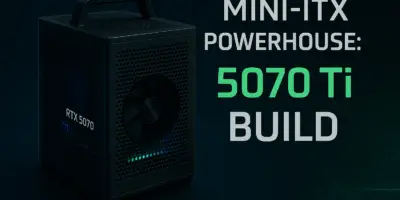Hey there, gaming enthusiasts! I know many of you have been eagerly waiting for this comparison between the RX 9070 and the RTX 5070. Well, I’ve got both cards and have thoroughly tested them to give you the definitive showdown. Plus, I’ll be walking you through an excellent 4K gaming build featuring one of these powerful GPUs.
Table of Contents
The Graphics Card Showdown: RX 9070 vs RTX 5070
Let’s cut right to the chase and dive into the comparisons:
Rasterization Performance
At 2K resolution without ray tracing, the RX 9070 is approximately 6.5% faster overall. While the RTX 5070 did edge ahead in a few select games, the overall advantage belongs to the RX 9070. When we bump up to 4K, that gap widens to about 9% in favor of the RX 9070.
Ray Tracing Performance
Ray tracing has traditionally been NVIDIA’s stronghold, but honestly, the performance between these two cards is surprisingly close. The RX 9070 is just about 3% slower in ray tracing workloads at 2K resolution – a difference that’s barely noticeable. At 4K with ray tracing, both cards perform nearly identically. Just keep in mind that neither card can truly handle native 4K ray tracing without upscaling technologies.
Power Consumption
Again, these cards are neck and neck. The RX 9070 draws around 230 watts while the RTX 5070 pulls about 250 watts – another negligible difference. Either card will run perfectly fine on a quality 600-650W power supply.
Memory Specifications
The RTX 5070 offers higher memory bandwidth thanks to GDDR7, while the RX 9070 provides more memory capacity – 16GB versus 12GB.
Upscaling Technologies
This is where things get interesting. The RTX 5070 supports DLSS 4, while the RX 9070 features FSR 4. Both technologies are excellent, and as I mentioned in my RX 9070 XT review, FSR 4 is a genuine competitor to DLSS from a technical standpoint. FSR 4 is currently supported by around 40 games and is rapidly gaining traction, though DLSS still holds the advantage in terms of the number of supported titles.
In the past, DLSS had both technical superiority and wider game support, but now its main advantage is just the larger game library. Each card brings different strengths to the table – the RTX 5070 offers DLSS and slightly better ray tracing, while the RX 9070 provides more VRAM and better rasterization performance.
Price to Performance
Both cards are supposed to retail at $550 MSRP, and at identical pricing, I’d give a slight edge to the RX 9070 for its faster overall performance and larger memory. But real-world pricing rarely matches MSRP these days.
My straightforward advice? Don’t overthink it. If they’re the same price, the RX 9070 gets a slight advantage. If there’s a price difference, just go for whichever is cheaper. Both are excellent options, and the price difference will likely matter more than the performance gaps.
Building a 4K Gaming Beast
For today’s build, I’ve chosen the RX 9070, specifically the ASUS Prime version. Let me tell you, ASUS has really outdone themselves with the cooling on this thing – during stress testing, it peaked at just 55°C. That’s seriously impressive! All the Prime series cards I’ve tested have had exceptional cooling performance.
The Components
CPU: AMD Ryzen 5 9600X3D
This is a 6-core, 12-thread processor running at up to 5.4 GHz boost clock, built on the Zen 5 architecture. It’s a solid chip – actually the strongest 6-core processor out there. But I’ll be honest with you: I’m not particularly in love with the Zen 5 9000 series processors (except for the 9800X3D).
Why? It’s not that they’re bad, but the Zen 4 7000 series offers nearly identical performance at a much lower price point. Until the Zen 5 prices drop to match Zen 4, I’d actually recommend something like the Ryzen 5 7500F instead. It’s about 30% cheaper while only being about 10% slower – much better value overall.
Motherboard: ASUS TUF Gaming B850M Plus
This board offers solid VRM with 14+2 power phases and excellent cooling, making it capable of handling all processors, even with overclocking. It provides three M.2 slots (one Gen 5 and two Gen 4), eight PCB layers for better memory compatibility and higher RAM speeds.
The I/O is fantastic – with three 10Gbps USB ports, four 5Gbps USB ports, four USB 2.0 ports, one 20Gbps Type-C port with 2.5Gbps LAN, HDMI, DisplayPort, and a BIOS flashback button.
My only real complaint? No built-in WiFi. There is a WiFi version available for about $20 more, and honestly, any board over $200 should include WiFi as standard in 2025. Otherwise, it’s a rock-solid motherboard.
CPU Cooler: ASUS Prime LC 240 RGB
This 240mm AIO liquid cooler is reasonably priced, and what I love most about it is how easy it is to install. The fan is pre-mounted to the radiator out of the box, and there are fewer cables than with other coolers. It looks clean, installs easily, and is priced right.
That said, this build with this processor doesn’t necessarily need a liquid cooler – a good air cooler would work perfectly fine if you want to save some money.
RAM: Patriot Viper Venom RGB DDR5-6000 CL30 (32GB)
When it comes to DDR5 platforms, I always recommend going with 32GB from the start rather than 16GB. For Ryzen systems, 6000MHz offers the best balance of performance and compatibility. You could go faster than 6000MHz on AMD platforms, but you might run into compatibility headaches – save yourself the trouble and stick with 6000MHz.
Storage: Kioxia G2 1TB SSD
I’ve used this SSD in several builds because it offers excellent value. While its raw speeds aren’t extraordinary, it includes DRAM cache, which gives it very stable performance. The only issue I’ve noticed is that it can run quite hot under load. Most mid-range and high-end motherboards include M.2 heatsinks (like our ASUS board does), so this isn’t a problem here. But if you’re using a budget board without M.2 cooling, you might want to consider alternatives like the WD SN850X or Samsung 990 Pro.
Case: ASUS Prime AP201
This micro-ATX case is compact but accommodates large components like GPUs up to 34cm long, supports top-mounted 360mm radiators, and takes standard ATX power supplies. It’s inspired by ITX case designs with the PSU mounted at the front, which might seem complicated, but assembly is actually super easy because all panels (sides, top, front) can be removed for complete access.
Build quality is excellent, and airflow is great too. It comes in two versions – one with a glass side panel (which I have) and one with mesh. The front panel includes a power button, audio ports, two USB 3.0 ports, and one Type-C port. At around $90-100, I think it’s reasonably priced for what you get – quality materials, good airflow, and ease of assembly. I’d recommend it if you want a smaller form factor build without the usual complications of compact systems.
Power Supply: ASUS Prime 850W Gold
While this build only needs about 600-650W, ASUS provided their Prime 850W Gold model. It comes with fully sleeved black cables and is 80+ Gold certified. After running stress tests, I can confirm it performs excellently. For this specific build, an 850W PSU is overkill, but it does give you headroom for future upgrades. Since the case is small, having a modular PSU is helpful as I only needed three power cables – the 24-pin motherboard cable, the 8-pin CPU cable, and two PCIe cables for the graphics card.
Total Build Cost
This entire setup comes in at around $1,700-1,800, making it an excellent 4K gaming system.
Gaming Performance
I tested this build in numerous games at 4K resolution, and the performance is honestly fantastic. Here are some highlights:
- Alan Wake 2: About 70 FPS at 4K High settings with FSR Quality. Unfortunately, FSR 4 isn’t supported yet, so we had to use FSR 3, which is still decent.
- Counter-Strike 2: Around 300 FPS at 4K Medium settings – excellent competitive performance. This game desperately needs FSR 4 support!
- Dying Light 2: Over 60 FPS at native 4K with High settings.
- Elden Ring: Steady 60 FPS at maximum settings.
- Far Cry 6: Excellent performance even at highest settings with ray tracing.
- Forza Horizon 5: FSR implementation in this game is superb. 4K with high refresh rates even at maximum settings.
- Hogwarts Legacy: This game is a resource hog, especially with RAM usage (over 26GB!). Still delivers excellent performance even at Ultra settings.
- Horizon Forbidden West: Supports FSR 4, which works brilliantly here. Solid high refresh rate at 4K.
- Indiana Jones: Another RAM-hungry title, particularly at Ultra settings, but maintains a stable 60 FPS.
- The Last of Us: Also supports FSR 4, delivering 70-80 FPS at 4K Ultra settings.
- Resident Evil 4: Works beautifully even with ray tracing at highest settings.
- Spider-Man: Needs a powerful CPU for high frame rates, especially with ray tracing. Supports FSR 4, delivering great frame rates.
- Starfield: One of AMD’s biggest sponsored titles, yet surprisingly still doesn’t have FSR 4 support. Still performs excellently at Ultra settings with FSR 3.
- Uncharted 4: Runs like butter at native 4K Ultra with high refresh rates.
- VALORANT: I wasn’t going to test it since it runs on practically anything, but I know it’s popular. Over 500 FPS even at highest settings.
- Warzone: Supports FSR 4 but it wasn’t working during testing, so I had to use FSR 3. Still provides excellent competitive performance.
Final Thoughts
This build delivers outstanding performance, especially at 4K resolution. If you connect it to a 2K monitor, the performance will be even better. Despite the relatively high price tag, the value is excellent, and you can save money on certain components to improve the value proposition even further:
- Replace the Ryzen 5 9600X3D with a Ryzen 5 7500F to save $60-70 with minimal performance impact, especially for 4K gaming where the GPU is the bottleneck.
- Opt for a budget air cooler instead of the AIO liquid cooler, saving another $60-70.
- Consider a 600-650W power supply instead of 850W if you don’t plan on significant future upgrades.
The rest of the components hit the sweet spot for value and performance, so I wouldn’t change much else.



